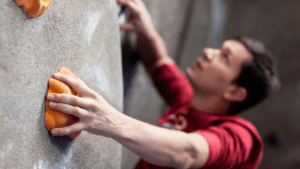Does this sound familiar: After rushing to get to work on time and getting through your busy, computer-bound work day, you head out for your post-workday run only to feel stiff, lethargic and achy in spite of ample sleep, adequate nutrition and proper hydration?
Long periods of sitting and inactivity can have a negative impact on your athletic performance. Sitting puts the hamstrings and hip flexors in a shortened position, increasing their susceptibility for chronic tightness. Prolonged inactivity also inhibits key muscles like the glutes and deep abdominals so that they’re less likely to fire normally on runs. This inhibition coupled with chronic tightness can lead to imbalances that can set a runner up for gait inefficiencies and injury susceptibility.
But earning your keep doesn’t have to negatively impact your running. By increasing your daily movement, priming your body before a run and taking care of tight spots with trigger point therapy you can begin offsetting the effects of a sedentary workday. Consider implementing some of these habits:
1. Move!
Prolonged inactivity is the major culprit with sitting. Get up and move, even if only briefly, every couple hours. Take a walk to fill up your water bottle, add a lap around the office after you eat lunch, or take the long route to your meeting. A few minutes every so often goes a long way.
2. Get an Upright or Standing Desk
If you’re lucky enough to work for a company that offers these, install it ASAP! These desks allow you to alternate between sitting and standing, giving you more movement and more muscle balance throughout the day.
3. Include Priming Exercises Before Your Run
After long periods of inactivity key muscle groups like the deep core muscles and the gluteal muscles are a little reluctant to fire appropriately. This is a big problem since these two areas are big players in hip stability. Take five minutes before your run to warm these muscles up and get them firing. Include front plank, lunges, hip thrusts, and single leg squats. You don’t need to do a full workout – 2-3 sets of 3-5 reps for each exercise will suffice. The idea is to get those muscles firing so once you head out the door they’re doing their job!
4. Release Tight Spots Regularly
Long periods of sitting means long periods of chronic tightness, especially in the hamstrings. Incorporating trigger point release work on spots that take a hit from sitting, like the Piriformis, the upper Hamstrings, and the Tensor Fascia Latae will go a long way to keeping those muscles released and happy. Get a tennis ball or lacrosse ball, and sit on it, applying pressure to tight spots in the glute muscles and upper hamstrings. Sit on the pressure for 30 seconds, until the initial discomfort subsides, then repeat on the opposite side.
How useful was this post?
Click on a star to rate it!
Average rating 0 / 5. Vote count: 0
No votes so far! Be the first to rate this post.






